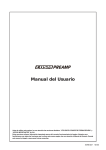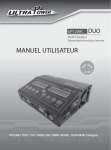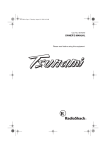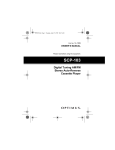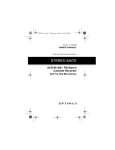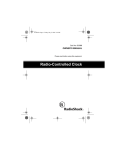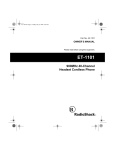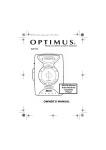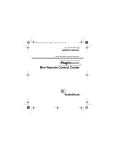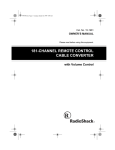Download Radio Shack 12-795 Owner`s manual
Transcript
12-795.fm Page 1 Friday, July 16, 1999 7:11 AM Cat. No. 12-795 OWNER’S MANUAL Please read before using this equipment. Multi-Band AC/DC Portable Radio 12-795.fm Page 2 Friday, July 16, 1999 7:11 AM FEATURES Your RadioShack Multi-Band AC/DC Portable Radio is designed to provide high-quality sound while you listen to up to 10 different radio bands. The portable design lets you use it almost anywhere. Its features include: We recommend you record your radio’s serial number here. The number is inside the radio’s battery compartment. Serial Number __________________ WARNING: Multiple Power Options — let you power the radio with standard AC power using the supplied cord, batteries (not supplied), or your car’s cigarette-lighter socket (using an optional DC adapter). MIC Jack — lets you connect a micro- phone with a 1/8-inch plug (not supplied) to the radio and hear sound from the microphone through the radio’s speaker (like a public address system). To reduce the risk of fire or shock hazard, do not expose this product to rain or moisture. CAUTION RISK OF ELECTRIC SHOCK. DO NOT OPEN. CAUTION: TO REDUCE THE RISK OF ELECTRIC SHOCK, DO NOT REMOVE COVER OR BACK. NO USER-SERVICEABLE PARTS INSIDE. REFER SERVICING TO QUALIFIED PERSONNEL. This symbol is intended to alert you to the presence of uninsulated dangerous voltage within the product’s enclosure that might be of sufficient magnitude to constitute a risk of electric shock. Do not open the product’s case. AFC (Automatic Frequency Control) — provides drift-free FM reception and reduced sound distortion. Carry Strap — easily attaches to the radio so you can carry it with you almost anywhere. Direction Finder — directional antenna lets you fine-tune the radio to improve AM reception. ! This symbol is intended to inform you that important operating and maintenance instructions are included in the literature accompanying this product. Caution: The directional antenna (DIRECTION FINDER) on top of the radio is not a handle. To avoid damaging the antenna, do not lift or carry the radio using the antenna. (Use the provided carry strap instead.) © 1999 Tandy Corporation. All Rights Reserved. RadioShack is a registered trademark used by Tandy Corporation. 2 ! 12-795.fm Page 3 Friday, July 16, 1999 7:11 AM CONTENTS Preparation ........................................................................................................... Connecting Power ........................................................................................... Using AC Power ....................................................................................... Using Batteries ......................................................................................... Using Vehicle Battery Power .................................................................... Connecting the Wire Antenna ......................................................................... Attaching the Carry Strap ................................................................................ 4 4 4 5 6 7 7 Operation .............................................................................................................. 8 Understanding the Bands ................................................................................ 8 AM Broadcast ........................................................................................... 8 Citizen Band ............................................................................................. 8 Short Wave 1/2 ......................................................................................... 8 FM Broadcast ........................................................................................... 9 TV Sound 1 ............................................................................................... 9 TV Sound 2 ............................................................................................... 9 VHF Marine ............................................................................................... 9 Air Craft ..................................................................................................... 9 Weather Band ........................................................................................... 9 Basic Radio Operation .................................................................................. 10 Reading the Tuning/Battery Meter ................................................................ 11 Using the P.A. (Public Address) Function ...................................................... 11 Using the Earphone ....................................................................................... 12 Listening Safely ...................................................................................... 12 Traffic Safety ........................................................................................... 12 Care ............................................................................................................... 13 The FCC Wants You to Know ........................................................................ 13 Specifications .................................................................................................... 15 3 12-795.fm Page 4 Friday, July 16, 1999 7:11 AM PREPARATION CONNECTING POWER You can power the radio from standard AC power using the supplied power cord, with batteries (not supplied), or from your vehicle’s cigarette-lighter socket (using an optional DC adapter). Follow these steps to connect AC power. 1. Be sure POWER is set to OFF, then set AC/DC on the back of the radio to AC. Caution: Connecting the radio to AC or vehicle battery power disconnects any internal batteries. However, batteries can leak chemicals that can corrode and damage the radio. Always remove the batteries if you: • will not be using the radio for a week or more • plan to use only AC or vehicle battery power for a week or more 2. Open the battery compartment cover, pull out the power cord, then replace the cover while routing the cord through the slot on the side of the cover. Using AC Power You can power the radio using the supplied AC power cord. Cautions: You must use the supplied AC power cord. Using any other power cord could damage the radio or the power cord. Contact your local RadioShack store for power cord replacement. ! • Always connect the power cord to the radio before you connect it to AC power. When you finish, disconnect the power cord from AC power before you disconnect it from the radio. 4 Cord Slot 3. Plug the cord into a standard AC outlet. Caution: Your radio’s power cord has a polarized plug (one blade is wider than the other). If you have difficulty inserting the plug into the outlet, do not force it! Turn the plug over and try again. 12-795.fm Page 5 Friday, July 16, 1999 7:11 AM Using Batteries You can power the radio with four D batteries (not supplied). For the best performance and longest life, we recommend RadioShack alkaline batteries. 3. Place four D batteries into the compartment on top of the attached ribbon and according to the polarity symbols (+ and –) marked inside. Cautions: • Use only fresh batteries of the required size and recommended type. • Do not mix old and new batteries, different types of batteries (standard, alkaline, or rechargeable), or rechargeable batteries of different capacities. Ribbon 4. Replace the cover. Replace the radio’s batteries when: Follow these steps to install batteries. 1. Be sure POWER is set to OFF, then set AC/DC on the back of the radio to DC. • The needle on the TUNING/BATTERY meter points toward the left of the green shaded (lower) portion of the meter, when POWER ON/OFF is set to ON and RADIO/P.A. is set to P.A. (see “Reading the TUNING/ BATTERY Meter” on Page 11). • Reception weakens or the sound distorts. • The radio does not operate properly. Warning: Dispose of old batteries promptly and properly. Do not burn or bury them. 2. Press down the tabs on the battery compartment cover and pull them out to remove the cover. Cautions: If you do not plan to use the radio with batteries for a week or longer, remove the batteries. Batteries can leak chemicals that can destroy electronic parts. Note: To easily remove the batteries, pull up on the attached ribbon. 5 12-795.fm Page 6 Friday, July 16, 1999 7:11 AM Using Vehicle Battery Power You can power the radio from a vehicle’s 12V power source (such as cigarette-lighter socket) using a 9V, 500 mA DC adapter (not supplied) available at your local RadioShack store. 2. Set the adapter’s voltage switch to 9V. 3. Insert the adapter’s 5.5 mm outer diameter/2.1 mm inner diameter barrel plug into the DC 9V jack on the back of the radio. Cautions: You must use a power source that supplies 9V DC and delivers at least 500 mA. Its center tip must be set to negative and its plug must fit the radio's DC 9V jack. Using an adapter that does not meet these specifications could damage the radio or the adapter. ! • Always connect the DC adapter to the radio before you connect it to the power source. When you finish, disconnect the adapter from the power source before you disconnect it from the radio. 4. Plug the other end of the adapter into the vehicle’s cigarette-lighter socket. Cigarette Lighter Socket Follow these steps to connect DC power. 1. Be sure POWER is set to OFF, and set AC/DC on the back of the radio to DC. 6 Note: If the radio does not operate when you connect a DC adapter, unplug the adapter from the cigarette-lighter socket and clean any ashes or debris from the socket. 12-795.fm Page 7 Friday, July 16, 1999 7:11 AM CONNECTING THE WIRE ANTENNA ATTACHING THE CARRY STRAP Besides the DIRECTION FINDER antenna and the built-in telescoping antenna, the radio comes with a separate wire antenna (about 10 feet long) for reception when you listen to the shortwave bands (SW or SW2). To connect the antenna, simply insert the antenna’s plug into ANT on the front of the radio. The radio comes with a carry strap that you can easily attach and use to carry the radio with you almost anywhere you go. Follow these steps to attach each end of the supplied strap to the hanger bars on the radio. For the best reception when using the wire antenna, fully extend the antenna and run it outside through a window (if possible). Note: If you lose or damage the supplied wire antenna, you can replace it with a shortwave antenna kit available at your local RadioShack store. 1. Insert one end of the strap into the hanger bar on one side of the radio. 2. Loop the strap end around the bar and pull up on the strap. 3. Insert the strap end into the lower part of the buckle. 4. Pull the strap end through the top of the buckle far enough to stop the strap from slipping. To shorten the strap for hand carrying, slide the two buckles together. To lengthen the strap for shoulder carrying, slide the two buckles apart. 7 12-795.fm Page 8 Friday, July 16, 1999 7:11 AM OPERATION UNDERSTANDING THE BANDS This radio lets you select from 10 different radio frequency bands. A scale showing the frequency range and tuning position for each band appears to the right of that band’s name on the radio’s multi-band display. This section briefly describes the frequency range of each band and the types of communication you can hear when you listen to that band. Notes: • CB reception is limited by range. Some conditions, such as electrical interference, natural obstructions (such as hills), humidity, or atmospheric conditions, could further limit reception. • For the best CB reception, be sure to fully extend the radio’s telescoping antenna. AM Broadcast Short Wave 1/2 Frequency Range: 530–1710 kHz Frequency Range: Communications: AM radio stations • SHORT WAVE 1: 4–6 MHz • SHORT WAVE 2: 7–12 MHz Citizen Band Frequency Range: 26.965–27.405 MHz Communications: Traffic and road condition announcements, and Channel 19 — the HELP channel, home-to-home, truckto-truck, dispatchers. 8 Communications: around the world. Broadcasts from 12-795.fm Page 9 Friday, July 16, 1999 7:11 AM Notes: • Reception varies according to the seasons of the year, the current weather conditions, change in atmosphere and the frequency you selected. • The best time for listening to shortwave broadcasts is in the evening. VHF Marine Frequency Range: 145–175 MHz Communications: Public service and marine band frequencies (such as police, fire department, taxi, truck and other private mobile transmissions). Air Craft FM Broadcast Frequency Range: 108–135 MHz Frequency Range: 88–108 MHz Communications: FM radio stations. Communications: Aircraft communications such as aircraft-to-aircraft or between air traffic control and aircraft. TV Sound 1 Frequency Range: Channels 2–6 Weather Band Frequencies: Communications: Audio portion of television broadcasts. TV Sound 2 Frequency Range: Channels 7–13 Communications: Audio portion of television broadcasts. 162.400 162.425 162.450 162.475 162.500 162.525 162.550 Communications: Weather information broadcasts. Note: You can generally expect to receive at least one of these channels in your area. 9 12-795.fm Page 10 Friday, July 16, 1999 7:11 AM BASIC RADIO OPERATION TUNING/BATTERYMeter DIRECTION FINDER Frequency Scale POWER RADIO/P.A. AFC TUNING FINE TUNING VOLUME TONE Band Selector MIC ANT EAR Follow these steps to turn the radio on/ off, select a radio band and station/frequency, and adjust the sound. 1. Turn VOLUME toward MIN until it stops. 2. Set RADIO/P.A. to RADIO. (To use the P.A. setting, see “Using the P.A. (Public Address) Function” on Page 11. 3. Turn the band selector to the band(s) you want to listen to. 4. If you selected any band other than AM, SW1 or SW2, fully extend the telescoping antenna on top of the radio. If you selected SW1 or SW2, connect the supplied wire antenna to ANT on the front of the radio. (See “Connecting the Wire Antenna” on Page 7.) 10 Telescoping Antenna Note: The radio uses the attached directional antenna (DIRECTION FINDER) for AM band reception. The position of the radio’s telescoping antenna does not affect AM band reception. 5. For reduced sound distortion and drift-free FM reception, set AFC (Automatic Frequency Control) to ON. 6. Set POWER to ON to turn on the radio. 7. Adjust VOLUME toward MAX to increase the volume, or toward MIN to decrease it. 8. Adjust TONE to get the sound you like. 12-795.fm Page 11 Friday, July 16, 1999 7:11 AM 9. To select a different station/frequency, rotate TUNING (the outside knob) on the front of the radio. The yellow bar on the multi-band scale moves to indicate the current tuning position. The needle on the TUNING/ BATTERY meter moves toward 10 as the signal strength increases or toward 0 as it decreases (see “Reading the TUNING/BATTERY Meter). Notes: • If you selected the AM band, turn DIRECTION FINDER (the directional AM antenna) on top of the radio to fine tune the selected AM station. • If you selected the SW1 or SW2 band, rotate FINE TUNING (the knob inside TUNING) to fine tune the selected SW frequency. 10. To turn off the radio when you finish, set POWER to OFF. READING THE TUNING/ BATTERY METER With POWER set to ON and RADIO/P.A. set to RADIO, the position of the needle on the top portion of the meter shows the current signal strength on a scale of 0 (weakest signal) to 10 (strongest signal). With POWER set to ON and RADIO/P.A. set to P.A., the position of the needle on the lower (green-shaded) portion of the meter shows the current battery strength. The needle points toward the right when the battery strength is strong, and moves to the left as the battery strength weakens. USING THE P.A. (PUBLIC ADDRESS) FUNCTION Follow these steps to connect a microphone with 1/8-inch (3.5-mm) plug (not supplied) to the radio and set the radio so you can hear sound from the microphone through the radio’s speaker. Note: Your local RadioShack store carries a wide selection of microphones. The radio’s TUNING/BATTERY meter indicates the current signal strength and the current battery strength (if you installed batteries). 1. Turn VOLUME toward MIN until it stops. 11 12-795.fm Page 12 Friday, July 16, 1999 7:11 AM 2. Set RADIO/P.A. to P.A. 3. Plug the microphone into MIC on the front of the radio. 4. Be sure POWER is set to ON, then speak into the microphone in a normal voice. 5. As you begin speaking, adjust VOLUME to a comfortable listening level. Note: To prevent feedback or highpitched sounds, keep the microphone pointed away from the radio and stand at least 3 feet away from (behind or beside) the radio. 3. Put the earphone in your ear and adjust VOLUME to a comfortable listening level. Listening Safely To protect your hearing, follow these guidelines when you use an earphone. • Set the volume to the lowest setting before you begin listening. After you begin listening, adjust the volume to a comfortable level. • Do not listen at extremely high volume levels. Extended high-volume listening can lead to permanent hearing loss. USING THE EARPHONE Follow these steps to attach the supplied earphone so you can listen to the radio without disturbing others. Connecting the earphone disconnects the speaker. • Once you set the volume, do not increase it. Over time, your ears adapt to the volume level, so a volume level that does not cause discomfort might still damage your hearing. Traffic Safety Do not wear an earphone while operating a motor vehicle or riding a bicycle. This can create a traffic hazard and could be illegal in some areas. 1. Turn VOLUME toward MIN until it stops. 2. Insert the earphone’s 1/8-inch (3.5mm) plug into the EAR jack on the front of the radio. 12 Even though some earphones let you hear some outside sounds when listening at normal volume levels, they still can present a traffic hazard. 12-795.fm Page 13 Friday, July 16, 1999 7:11 AM CARE AND MAINTENANCE Your RadioShack Multi-Band AC/DC Portable Radio is an example of superior design and craftsmanship. The following suggestions will help you care for your radio so you can enjoy it for years. Keep the radio dry. If it gets wet, wipe it dry immediately. Liquids might contain minerals that can corrode the electronic circuits. Use and store the radio only in normal temperature environments. Temperature extremes can shorten the life of electronic devices, damage batteries, and distort or melt plastic parts. Keep the radio away from dust and dirt, which can cause premature wear of parts. Handle the radio gently and carefully. Dropping it can damage circuit boards and cases and can cause the radio to work improperly. Use only fresh batteries of the required size and recommended type. Batteries can leak chemicals that damage your radio’s electronic parts. Wipe the radio with a damp cloth occasionally to keep it looking new. Do not use harsh chemicals, cleaning solvents, or strong detergents to clean the radio. Modifying or tampering with the radio’s internal components can cause a malfunction and might invalidate its warranty and void your FCC authorization to operate it. If your radio is not performing as it should, take it to your local RadioShack store for assistance. [If the trouble is affecting the telephone lines, the phone company can ask you to disconnect your radio until you have resolved the problem. 13 12-795.fm Page 14 Friday, July 16, 1999 7:11 AM FCC DECLARATION OF CONFORMITY This device complies with Part 15 of the FCC Rules. Operation is subject to the following two conditions: (1) this device may not cause harmful interference, and (2) this device must accept any interference received, including interference that may cause undesired operation. Product: Model: Responsible Party: Phone: Multi-Band AC/DC Portable Radio 12-795 RadioShack 100 Throckmorton Fort Worth, TX 76102 817-415-3200 THE FCC WANTS YOU TO KNOW This equipment has been tested and found to comply with the limits for a Class B digital device, pursuant to Part 15 of the FCC Rules. These limits are designed to provide reasonable protection against harmful interference in a residential installation. This equipment generates, uses and can radiate radio frequency energy and, if not installed and used in accordance with the instructions, may cause harmful interference to radio communications. 14 However, there is no guarantee that interference will not occur in a particular installation. If this equipment does cause harmful interference to radio or television reception, which can be determined by turning the equipment off and on, the user is encouraged to try to correct the interference by one or more of the following measures: • Reorient or relocate the receiving antenna. • Increase the separation between the equipment and receiver. • Connect the equipment into an outlet on a circuit different from that to which the receiver is connected. • Consult your local RadioShack store or an experienced radio/TV technician for help. • If you cannot eliminate the interference, the FCC requires that you stop using your radio. Changes or modifications not expressly approved by RadioShack may cause interference and void the user’s authority to operate the equipment. 12-795.fm Page 15 Friday, July 16, 1999 7:11 AM SPECIFICATIONS Bands AM ...................................................................................................... 530–1710 kHz CB (Channels 1–40) ................................................................... 26.965–27.405 MHz SW1 ........................................................................................................ 4.0–6.0 MHz SW2 ...................................................................................................... 7.0–12.0 MHz FM ........................................................................................................... 88–108 MHz AIR ........................................................................................................ 108–135 MHz TV2 (Channels 7–13) ............................................................................ 176–218 MHz VHF ....................................................................................................... 145–175 MHz WX ................................................................................................ 162.4–162.55 MHz TV1 (Channels 2–6) ........................................................................ 59.75–87.75 MHz General Power Output ................................................................................................. 900 mW Power Requirements ............................................................... AC 120V, 60 Hz, 5 W; 6.0 Volts (Four D Batteries); 9V DC Center Negative Dimensions (HWD) .............................................................. 101/4 × 145/8 × 53/8 Inches (260 × 372 × 136 mm) Weight ............................................................................................................ 5.53 lbs (2.51 kg) Antenna ................................................................. FM Telescoping, Direction Finder Included Accessories ............................................ Wire Antenna (about 10 feet long) Earphone, Carry Strap Specifications are typical; individual units might vary. Specifications are subject to change and improvement without notice. 15 12-795.fm Page 16 Friday, July 16, 1999 7:11 AM Limited Ninety-Day Warranty This product is warranted by RadioShack against manufacturing defects in material and workmanship under normal use for ninety (90) days from the date of purchase from RadioShack companyowned stores and authorized RadioShack franchisees and dealers. EXCEPT AS PROVIDED HEREIN, RadioShack MAKES NO EXPRESS WARRANTIES AND ANY IMPLIED WARRANTIES, INCLUDING THOSE OF MERCHANTABILITY AND FITNESS FOR A PARTICULAR PURPOSE, ARE LIMITED IN DURATION TO THE DURATION OF THE WRITTEN LIMITED WARRANTIES CONTAINED HEREIN. EXCEPT AS PROVIDED HEREIN, RadioShack SHALL HAVE NO LIABILITY OR RESPONSIBILITY TO CUSTOMER OR ANY OTHER PERSON OR ENTITY WITH RESPECT TO ANY LIABILITY, LOSS OR DAMAGE CAUSED DIRECTLY OR INDIRECTLY BY USE OR PERFORMANCE OF THE PRODUCT OR ARISING OUT OF ANY BREACH OF THIS WARRANTY, INCLUDING, BUT NOT LIMITED TO, ANY DAMAGES RESULTING FROM INCONVENIENCE, LOSS OF TIME, DATA, PROPERTY, REVENUE, OR PROFIT OR ANY INDIRECT, SPECIAL, INCIDENTAL, OR CONSEQUENTIAL DAMAGES, EVEN IF RadioShack HAS BEEN ADVISED OF THE POSSIBILITY OF SUCH DAMAGES. Some states do not allow the limitations on how long an implied warranty lasts or the exclusion of incidental or consequential damages, so the above limitations or exclusions may not apply to you. In the event of a product defect during the warranty period, take the product and the RadioShack sales receipt as proof of purchase date to any RadioShack store. RadioShack will, at its option, unless otherwise provided by law: (a) correct the defect by product repair without charge for parts and labor; (b) replace the product with one of the same or similar design; or (c) refund the purchase price. All replaced parts and products, and products on which a refund is made, become the property of RadioShack. New or reconditioned parts and products may be used in the performance of warranty service. Repaired or replaced parts and products are warranted for the remainder of the original warranty period. You will be charged for repair or replacement of the product made after the expiration of the warranty period. This warranty does not cover: (a) damage or failure caused by or attributable to acts of God, abuse, accident, misuse, improper or abnormal usage, failure to follow instructions, improper installation or maintenance, alteration, lightning or other incidence of excess voltage or current; (b) any repairs other than those provided by a RadioShack Authorized Service Facility; (c) consumables such as fuses or batteries; (d) cosmetic damage; (e) transportation, shipping or insurance costs; or (f) costs of product removal, installation, set-up service adjustment or reinstallation. This warranty gives you specific legal rights, and you may also have other rights which vary from state to state. RadioShack Customer Relations, 200 Taylor Street, 6th Floor, Fort Worth, TX 76102 We Service What We Sell 04/99 RadioShack A Division of Tandy Corporation Fort Worth, Texas 76102 07A99 811-296091-031 Printed in China
















